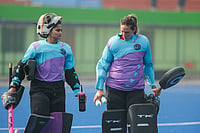
“Ara zilla ghar baa, kaun baat ka darr baa” (If you’re from Ara, what have you got to be scared of)...that’s what they say in this neck of the woods, the colloquial motto of the cheerfully unafraid native of Ara. Yes, I partly qualify, but it was still a completely new world to me when I was offered Anaarkali of Aarah. My roots lie in the region. My maternal grandfather’s family is from Patna (grandma was from Banaras). But I never grew up in Bihar. I had no idea about Ara, or what made it tick, what produced its natural ebullience. That’s why, when I agreed to do the film, I decided to go down and see for myself what it was really like. Ara was not only just a setting for the film, it was like a whole cultural universe. And so I landed there, more than once, to prepare for the character, to soak in the place and its sights and sounds.
Ara was a revelation for me. As I came to realise, so many historical and cultural lines pass through this meridian of central Bihar. Babu Kunwar Singh, for instance—one of the unlikely heroes of 1857, the indomitable man who rode his steed into battle against Company troops at age 80. I didn’t know he actually belonged to Ara. Turns out he was the zamindar of Jagdishpur, now a tehsil in this nucleus of Bhojpur region, and legends about him abound locally, though he’s less memorialised elsewhere. Or the folk playwright Bhikhari Thakur, from the district Saran, who drew on homespun songs of separation relating to the ‘girmitiyas’ who migrated in their thousands from this region to Mauritius, Fiji, the Caribbean et al. Or sites such as the Ramna Maidan, still echoing with slogans from the freedom struggle days.
The town itself has become an ‘education’ hub these days, a pit-stop for the outwardly mobile youth of Bihar. Students come to Ara from all over to prepare for civil services and other competitive exams. Some of them, naturally, don’t make it but are forever marked by the endeavour. I came across Pappuji—an educated chap, with a bonafide degree, who speaks fluent English and can engage in animated conversation on philosophy and such subjects for hours. He sells tea near Ramna Maidan these days. I had a great time meeting such people everywhere in Ara. I first visited around Dussehra and met members of the local orchestra party. I hung out with them, observed them, studied their body language. Seed material for my rustic Anaarkali.
My character in the film is that of an orchestra singer from Bihar whose shows revolve around risqué songs rife with double entendre. Rather than a filmi exaggeration, I wanted to keep the look of the character as close to reality as possible. I, therefore, did a lot of shopping in and around Gopal Market in Ara. Other than Anaarkali’s stage costumes, I bought all her clothes for everyday wear in the film from there—local roadside thela pret-a-porter! My logic was that someone like Anaarkali wouldn’t spend more than Rs 50 a metre on her clothes. I wanted to see a performance of the orchestra party in Ara but the festival season had ended by the time I reached on my second trip. So I headed to Mathura where I saw a live performance by these women. Till that point, I’d visualised Anaarkali as someone who primarily sang, but now I realised these women could dance as well! I promptly called up my producer Sandip Kapur and writer-director Avinash Das—we needed a choreographer! This was shortly before the shooting was to get under way.
Anaarkali of Aarah has been my most challenging role so far, much more than Nil Battey Sannata (2016). It was an emotionally draining experience in the extreme. Anaarkali’s character keeps a lot of anger bottled up inside her, a sense of injustice simmering all the time. As Chaplin used to say, human life could look comic from a distance, but up close it’s essentially tragic. I’m glad there’s a buzz about the film even among elite audiences (Karan Johar was generous enough to release the poster)—it always feels good to break a few silos.
Feeling outraged in advance is in vogue. Sure enough, some protests erupted in Ara prior to the release, with some worthies speculating the film would show their town in poor light. They could’ve waited and watched the film instead of jumping to conclusions. The film wasn’t meant to be about the town specifically. The name was basically chosen because the alliteration sounded good. We could as well have called it Munni of Muzaffarpur!
(The writer is a Bollywood actress whose latest release, Anaarkali of Aarah, has opened to rave reviews)





















